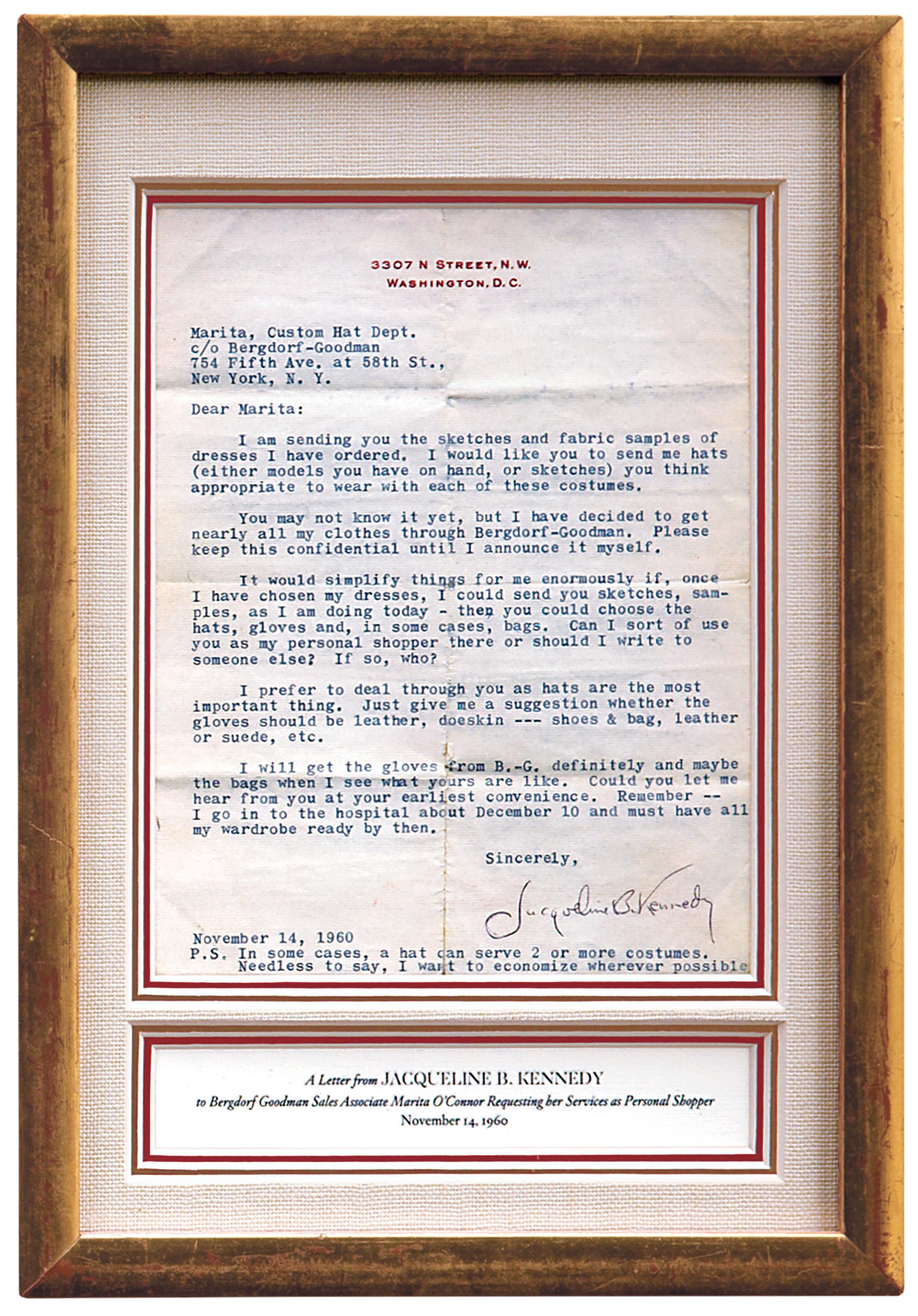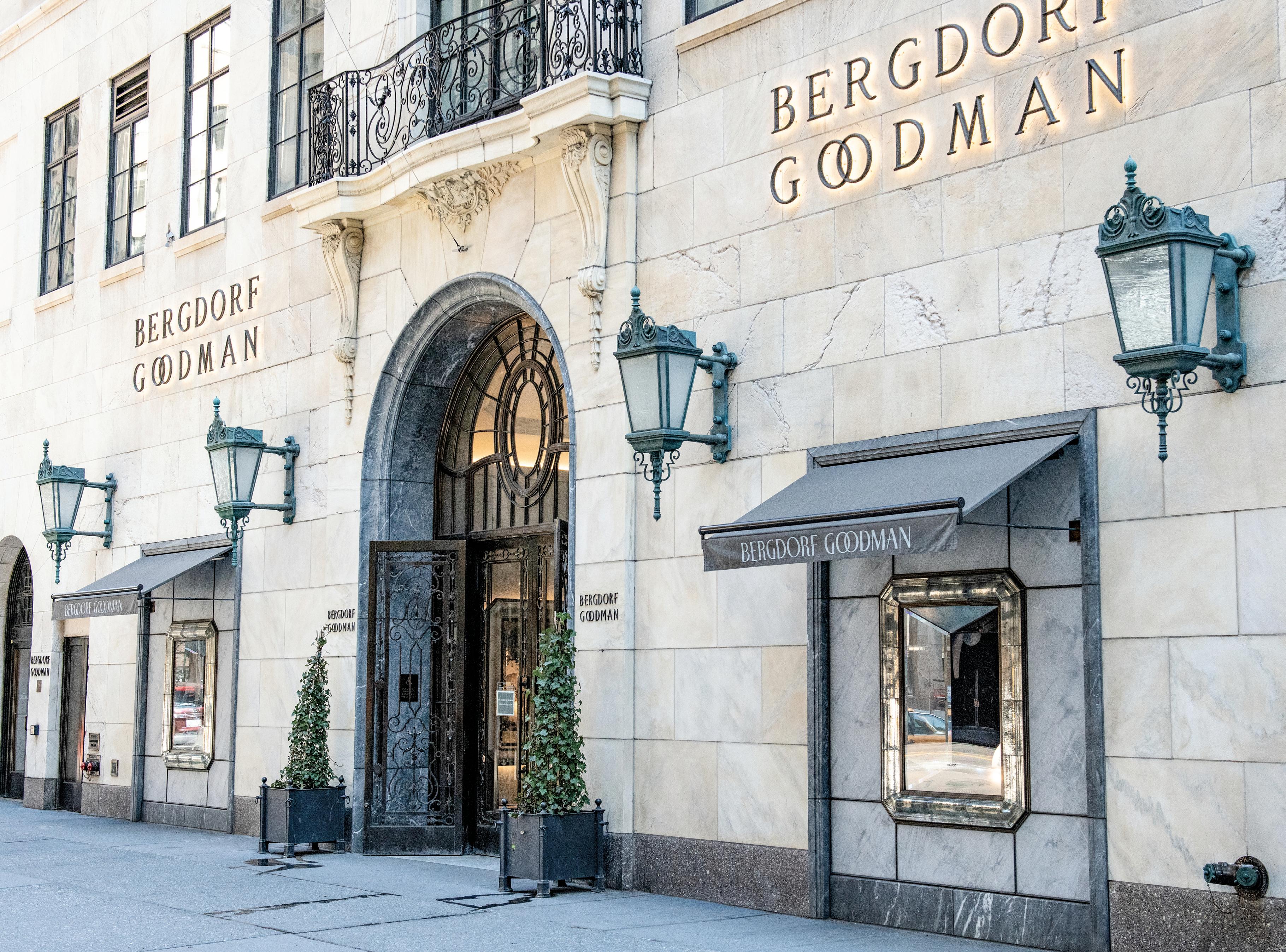Please note that the following is a digitized version of a selected article from White House History Quarterly, Issue 69, originally released in print form in 2023. Single print copies of the full issue can be purchased online at Shop.WhiteHouseHistory.org
No part of this book may be reproduced or distributed in any form or by any means, electronic or mechanical, including photocopying, recording, or by any information storage and retrieval system, without permission in writing from the publisher.
All photographs contained in this journal unless otherwise noted are copyrighted by the White House Historical Association and may not be reproduced without permission. Requests for reprint permissions should be directed to rights@whha.org. Contact books@whha.org for more information.
© 2023 White House Historical Association. All rights reserved under international copyright conventions.

KENNEDY’S Letter to Bergdorf Goodman


91 OPPOSITE AND BELOW: BRUCE WHITE FOR THE WHITE HOUSE HISTORICAL ASSOCIATION / TOP: GETTY IMAGES white house history quarterly
“Hats are the most important thing”
JACQUELINE
MARGARET STROLLE
when her husband, john f. kennedy, won the presidential election in November 1960, Jacqueline Kennedy knew that fashion critics as well as the public would scrutinize her fashion even more than they had during the campaign. A reminder of her determination to be properly dressed is a framed letter long displayed on the seventh oor of Bergdorf Goodman. At Fifth Avenue between 57th and 58th Streets, the New York Citybased department store has o ered custom clothing as well as luxury ready-to-wear pieces for more than a century. Dated November 14, 1960, and typed on stationery embossed with the Kennedys’ Georgetown address the letter is addressed to Marita O’Connor at Bergdorf’s custom hat department. Mrs. Kennedy wrote:
I am sending you the sketches and fabric samples of dresses I have ordered. I would like you to send me hats (either models you have on hand, or sketches) you think appropriate to wear with each of these costumes. You may not know it yet, but I have decided to get nearly all my clothes through BergdorfGoodman. Please keep this confidential until I announce it myself.
It would simplify things for me enormously if, once I have chosen my dresses, I could send you sketches, samples, as I am doing today— then you could choose the hats, gloves and, in some cases, bags. Can I sort of use you as my personal shopper there or should I write to someone else? If so, who?
I prefer to deal through you as hats are the most important thing. Just give me a suggestion whether the gloves should be leather, doeskin—shoes & bag, leather or suede, etc.
I will get the gloves from B.-G. definitely and maybe the bags when I see what yours are like. Could you let me hear from you at your earliest convenience. Remember—I go in to the hospital about December 10 and must have all my wardrobe ready by then.
As Mrs. Kennedy explains, she had already ordered dresses and requested that Marita O’Connor select matching accessories, of which hats would be the “the most important thing.” Mrs. Kennedy had not normally worn hats and she felt “absurd” in them. However, they still featured as a part of a traditional woman’s wardrobe in the early
Jacqueline Kennedy at her typewriter in the Kennedys’ Georgetown residence, October 1960.

previous spread left
Jacqueline Kennedy’s typewritten letter framed and on display on Bergdorf Goodman’s seventh floor, 2023.
previous spread right
Wearing a hat supplied by Bergdorf Goodman, First Lady Jacqueline Kennedy turns to the television camera during President John F. Kennedy’s Inauguration, January 20, 1961. Hats from Bergdorf Goodman were carefully packed in branded hatboxes.
92 GETTY IMAGES white house history quarterly
Founded in 1899, Bergdorf Goodman has stood at Fifth Avenue and Fifty-eighth Street in Midtown Manhattan since 1928. The entrance to

1960s, so they needed to be worn by a first lady.1 She also did not want to be thought of as spending excessive amounts on fashion. In a postscript she added:
In some cases, a hat can serve 2 or more costumes. Needless to say, I want to economize wherever possible.
As a luxury store with in-house designers and a New York City address, Bergdorf Goodman did not allow for a great deal of economizing, but it fit the politically necessary criterion of being an American company and so the most appropriate choice for an American first lady.
Bergdorf saleswomen, known as “vendeuses,” memorized the measurements and tastes of elite customers who could visit in person, but the heavily pregnant incoming rst lady would have to place her orders by letter and sketch. She would actually give birth to her son, John F. Kennedy Jr., on November 25, 1960, well before the December 10 date she anticipates in the letter. She asks O’Connor to be her “personal shopper,” selecting accessories to match sketches of costumes already selected. A former Bergdorf-Goodman personal shopper
actually suggests that Kennedy may have come up with the term, although the Oxford English Dictionary cites the earliest usage as a 1941 issue of the William and Mary Quarterly 2
Like other first ladies before her, Mrs. Kennedy admired French fashion, but in a new media age, sartorial treason would be more visible to critics. The Kennedy clan would ultimately overrule the decision for Bergdorf Goodman to supply the future first lady’s clothing in favor of Oleg Cassini, a longtime family friend. Jacqueline Kennedy still needed the hats and other accessories that the store could provide.
Mrs. Kennedy continued to shop at Bergdorf Goodman after her time as first lady. She moved to New York City in 1964, living there off and on until her death in 1994. Bergdorf Goodman remains open today after twelve decades in operation .
NOTES
93 GETTY IMAGES white house history quarterly
the luxury department store is seen here in 2018.
1. Susan Black,” Mrs. Kennedy’s Cabinet,” New Yorker, January 14, 1961, 77, Steven Gaines “How Halston Became Halston,” Vanity Fair, September 1991.
2. Wendy Mason, “Antiques: A Pillbox Hat for the Lady,” New York Times, March 6, 1998, 106; OED Online www.oed.com; Minnie Clare Boyd, review of The Cotton Kingdom by Charles S. Davis, the William and Mary Quarterly 21: 3 (July 1941): 283–84.





